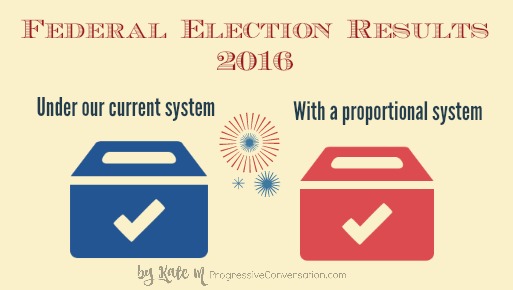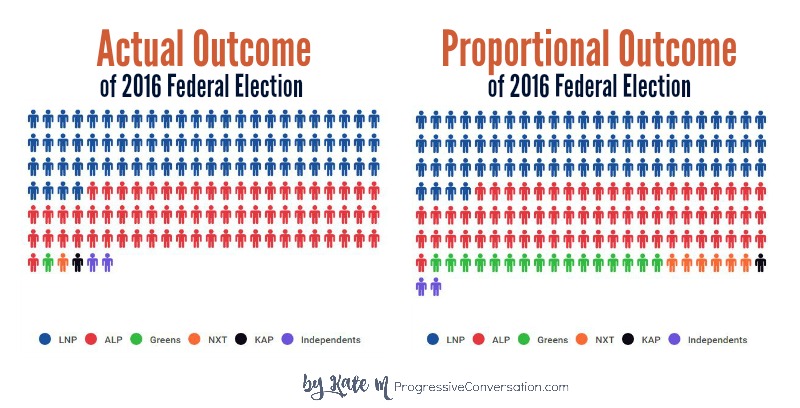Would we have an LNP government now if we used the NZ voting system?

If you look back at the last thirty Australian Federal Elections, the Australian Labor and Liberal National Parties have won the countrywide two-party preferred vote exactly fifteen times each – a 50/50 split. If our electoral system were accurately translating Australian voters’ wishes into election outcomes – as Prime Minister Malcolm Turnbull said in February that it should – then this would mean that each Party would have held the reins of government exactly half of the time. But they haven’t. In fact the LNP has been in government nearly twice as often as Labor (nineteen times to Labor’s eleven).
Great news for LNP supporters – not so much for everyone else.
How should a voting system work?
According to Malcolm Turnbull:
These were the words Turnbull used to justify changes made to the Senate voting structure in February this year – citing Ricky Muir’s election to the Senate with less than 1% of the primary vote as justification that the current Sentate voting system was broken.
Turnbull is right – to the extent that the goal of an electoral system in any democracy should be to create a parliament that represents the wishes and voices of its citizens. Unfortunately, Turnbull’s actions didn’t entirely reflect the sentiment he expressed. If they had, then his focus would have been firstly on reforming the voting system we use for the House of Representatives. Why? Because the voting system used to elect politicians to our House of Reps was – and remains – far less representative of Australian voters’ wishes than the one used for the Senate.
What’s wrong with the voting system used for Australia’s House of Representatives?
In determining whether any voting system accurately represents the wishes of its voters, you need to look at who or what it is that needs to be represented. When it comes to elections, the two main ways citizens of a democracy typically expect to be represented are:
- By location – we want people who can speak to the issues that are relevant to where we live; and
- By political perspective (or party) – we also want a say in the policies our government implements and who gets to govern the country.
The main problem with the voting system we currently use in our House of Representatives is that it is outdated. Unlike other more modern systems, it focuses primarily on ensuring that only one of the two expectations listed above is adequately catered for – location.
While Australian voters do get a say in the political perspective of the politicians elected to our House of Representatives, it is secondary to location. This is because even though each electorate gets to vote for representatives from different political parties, the drawing of electoral boundaries between groups of voters – each of which only gets to elect a single representative – distorts the way seats are allocated to different political parties. (Want to know more? For an explanation on how physical electoral boundaries can distort an election outcome, see Gerrymandering explained.)
How has this impacted the outcome of elections in Australia?
As previously mentioned, over the last thirty Federal Elections, Australia has ended up with an LNP government roughly two-thirds of the time despite voter preferences indicating a 50/50 split. That’s up to twelve more years of an LNP government than the people of Australia actually wanted.
Further, if you take a more detailed look at some of the individual Federal Election results, there are other distortions. For example, in the 2013 Federal Election results, only 45% of Australians picked the LNP as their first preference for the House of Representatives, and yet the LNP ended up with 60% of the seats. Conversely, the minor Parties and Independents received just over 21% of primary votes, but ended up with only 3% of the seats.
What would a more accurate voting model look like?
A proportional electoral system is a voting model which factors in both location and political perspective. It typically does this by giving citizens two votes – one for an individual to represent their electorate and another for a political Party (or independent) that best represents their political views.
This type of voting system is used in 21 out of 28 democracies in Europe and is also used by our Kiwi neighbours. The great thing about this model is not only that it is able to more accurately reflect voters’ wishes, but according to former associate professor Klaas Woldring:
“The European model of proportional representation is co-operative, rather than adversarial in nature…Apart from being co-operative, it also ensures diverse and democratic representation. There are no byelections, pork-barrelling or horse trading on preferences behind closed doors.”
To give you some idea of how a proportional voting system works in practice – let’s take a quick look at the New Zeland model.
Proportional voting in New Zealand
In the New Zealand Mixed Member Proportional (or MPP) voting system, there are 120 seats in parliament – 71 of these are determined by whoever gets the most votes in each electorate (or location), and the balance are allocated proportionally according to the ‘share’ of the vote that a particular political party receives (as long as they receive a minimum of 5% of the vote across the country). Here’s a quick video which provides an overview of how New Zealand’s MPP works:
https://youtu.be/8Uk44aykGg4
The New Zealand system is arguably more accurate than our current system because it factors in representating its citizens views both by location and by political perspective.
Would the outcome of the 2016 Australian Federal Election have been different if we used proportional voting?
Very possibly – yes. Obviously we don’t have that system in place, nor do we know exactly what a similar system would look like in Australia if deployed, so it’s impossible to tell for sure. However based on modelling I did using current AEC data and applying NZ rules for proportional allocation – I have looked at what the recent Election outcome might have been if Australia had added a ‘proportional’ component to determining who won seats in our House of Representatives. Here’s a visual representation of the difference between the actual outcome of the 2016 Federal Election, and what the House of Reps might have looked like if we had a proportional system in place:
- The big winners when you apply a proportional count would be:
- The Greens – who would have sixteen MPs in the House of Representatives (instead of one in our current model)
- The Nick Xenophon party – who would have six MPs in the House of Representatives (instead of one in our current model)
- All other elected representatives (under our current system) would keep their seats – including the two independent candidates (McGowan and Wilkie).
The bottom line: The ALP could be in government right now if we were using a similar model to the Kiwis
In the model above, neither the LNP nor the ALP have the 86 seats needed to form Government in their own right. However, in this scenario, assuming the ALP had entered into an arrangement with the Greens and Andrew Wilkie – even if only on supply and confidence motions – then they would have enough seats to form government. This suggests that had we used a proportional model in the 2016 Federal Election, the ALP could be in government now, and Bill Shorten would be Prime Minister.
What we do know
Any model can only ever be hypothetical. But what we do know about our current electoral system for the House of Representatives is that it is outdated and inaccurate. It’s so inaccurate in fact, that it has arguably resulted in:
- Australia having 12 more years of an LNP government than we otherwise might have; and
- The ALP potentially missing out on an opportunity to take the reins of government in 2016.
Turnbull promised in February this year to give us an electoral system that more accurately translates Australians’ votes into an election result. Clearly we’ve still got a way to go.
This article was first published on ProgressiveConversation.
(Note: there was an error in one of my numbers – picked up by an observant reader. As a result, I updated them at 5:30 pm on 28 July to fix this error. The overall conclusions are the same.)
Assumptions used/notes regarding my modelFor those interested in the detail behind my model above, here are the assumptions I used and some additional notes:
|
Like what we do at The AIMN?
You’ll like it even more knowing that your donation will help us to keep up the good fight.
Chuck in a few bucks and see just how far it goes!
Your contribution to help with the running costs of this site will be gratefully accepted.
You can donate through PayPal or credit card via the button below, or donate via bank transfer: BSB: 062500; A/c no: 10495969











9 comments
Login here Register here-
Jusme -
2353 -
lawrencesroberts -
wam -
townsvilleblog -
Freethinker -
Wayne Turner -
diannaart -
Christopher
Return to home pageI’d vote for that. Bit like a permanent joint sitting.
I reckon we pay far too many politicians.
How about abolish the lower house, make the Senate the government (one step further than the proposal above).
Have a President (yes republic!) with bee sting veto power.
Abolish state governments but empower local councils with lots of lobby access to the federal gov, further empowered by lessening private interest lobbyists (and their donations).
Some version of Proportional Representation would be a better outcome – but first we have to get over the perception that there has to be a majority Government in Australia for Parliament to work.
Did anyone else find the Coalition Parties claiming that they were the only ones that could produce stable majority government when the Liberal Party and the National Party have never held an absolute majority federally?
Stop the near monopoly of the right wing media and everything would look a lot different.
whew a system that works for a country smaller than greater sydney with no states no ancient constitution(repealed 30 years ago) a non European population of about 25% and is centred around the Indigenous population (with Maorii only seats) sounds looney?
The big winner should be the ATSI population but hanson would bolt past them. That sounds great!
How about the first past the post aspect?
herbert lnp win (hanson double the loonies)
adelaide libs win
bradden libs win
cowan libs win
longman libs win (X 5 times the loonies)
in nz
nats won 41 seats 19 gifted 1100000 votes
labour 27 seats 5 gifted 600000 votes
the loonies won 0 seats 14 gifted from 250000 votes
hansonists won 0 seats 11 seats gifted from 200000 votes
consevative no seat no gifts but 90000 votes??
yes looks like a fair apportioning?
ps jusme we have 150 members nz has 120 we have 76 senators nz 0 but who would dump the senate and leave the libs in charge???
Kate, a very interesting case indeed.
Proportional vote without preferences will be my choice.
“Stop the near monopoly of the right wing media and everything would look a lot different.” – Spot on,and our mediaocracy needs to stop.
The Greens are often maligned by both Labor and the LNP as only achieving a single seat in the HoR.
Which makes a person wonder if Labor is really interested in governing FOR Australia, even with the old voting representation by location Labor could do better.
With proportional voting, Labor would be in power more often than the LNP.
The problem with your analysis is that you are conflating the Liberal, National & LNP Queensland votes. I would like to see how their specific votes translate to seats.